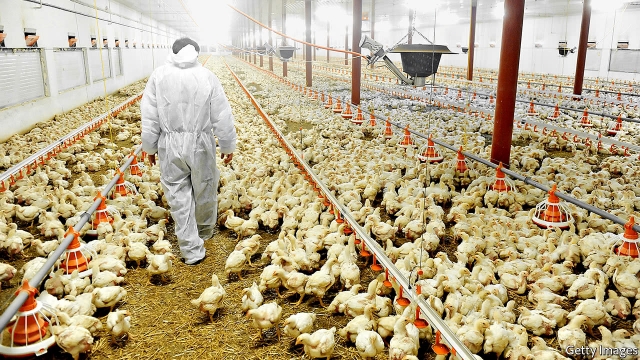The Economist: How the use of antibiotics in poultry farming changed the way America eats
Industrial farming
How the use of antibiotics in poultry farming changed the way America eats
A new book about the rise of cheap chicken
Sep 21st 2017| CHICAGO
WILL HARRIS is one of the heroes of “Big Chicken”, a new book by Maryn McKenna that looks at the widespread use of antibiotics in poultry farming. After finishing his studies at the University of Georgia’s School of Agriculture in 1976, Mr Harris deployed all the instruments in his new toolkit to increase his farm’s profits: chemical fertilisers, pesticides, land tillage, antibiotics, hormones. They did wonders for cost-savings, he says, but made him increasingly uncomfortable. White Oak Pastures, his farm in western Georgia, has come full circle over 150 years. Transformed into an industrialised, commoditised and centralised agricultural operation, the farm has now reverted to ways that his grandfather might recognise. With its verdant 3,000 acres grazed by rabbits, sheep, pigs, goats, turkeys, ducks, geese, guinea hens, bees and chickens, it is now a textbook example of multi-species, pasture-based organic farming.
Few farmers in America dare to take such a radical step away from industrial farming methods. Ms McKenna shows how, for decades, the demand for “meat for the price of bread” has overridden other concerns. Around 15,400 tonnes a year, a whopping 80% of all antibiotics sold, go to farmers. Chicken farmers use even more than those who raise cattle or pigs. Only a small percentage of the drugs are used to cure illnesses. Their main function is to make the broilers fatten up more quickly or to act as a prophylactic against the cramped conditions in which they are raised. A chicken’s weight at slaughter today is twice what it was 70 years ago, and it achieves such heft in half the time.
After the deprivations of the second world war, the new wonder drugs were welcomed by farmers, who could sell bigger birds much more cheaply to consumers hungry for affordable protein. The downsides were not immediately obvious. Even so, some scientists warned about the practice right from the beginning.
Animals receive antibiotics in their feed and water, which creates antibiotic-resistant bacteria in their gut. These drug-resistant bacteria can then spread into the environment in the soil or the water, and can even infect animals that are sold for human consumption. Any resulting infections are often far removed from the food that caused them, which is why it takes some detective work to trace them back. Each year salmonella causes around 1.2m cases of food poisoning, of which 19,000 result in hospitalisation and 380 in death, according to the Centres for Disease Control and Prevention. The death rate is highest among children under five. Most of these illnesses are caused by antibiotic-resistant bacteria, and most of that bacteria comes from industrially produced chicken.
One villain in Ms McKenna’s account is Thomas Jukes, a British biologist, who in 1948 tested different supplements, including one with antibiotics, in the diets of chickens. When he ended his experiment all the chickens that received supplements had gained at least a little weight, but the ones ingesting antibiotic leftovers had gained by far the most. This was the start of the use of antibiotics to promote growth. Mr Jukes realised the bacteria in the chicken’s gut would develop resistance, but would not concede the harm this could do, a view he stuck to until he died in 1999. Concern about antibiotic-resistant bacteria in humans has grown since.
After a particularly nasty outbreak of food poisoning from salmonella in chicken in 2013, regulators and consumers have become more aware of the dangers of bingeing on antibiotics-infused drumsticks. In 2014 Jim Perdue, chairman of Perdue farms, one of the largest poultry companies, announced that his company would not use antibiotics in its hatcheries any more. Walmart, the world’s biggest supermarket chain, McDonald’s, the world’s biggest fast-food chain, Kentucky Fried Chicken, Chick-fil-A and many others are stopping or phasing out. In January this year the Food and Drug Administration came into line with the EU, which had banned the use of antibiotics for growth promotion in livestock farming 12 years ago. The drugs are allowed for medicinal use, but only under the supervision of a veterinarian.
Mr Harris says he would have gone broke had he started his farming experiment in the 1970s, but consumer demand has been shifting. His grass-fed beef costs 30% more than grain-fed beef at Whole Foods, a posh supermarket; his pork costs 40% more than the mainstream variety and the price of his chicken is 200% higher. He is not making any money with the chicken, which is subsidised by the cattle. But he is hopeful that chicken will again be seen as a special Sunday treat. Last year Americans ate more than 92lb of chicken compared with 28lb in 1960. As prices are likely to rise thanks to the new regulations, less will be more.
